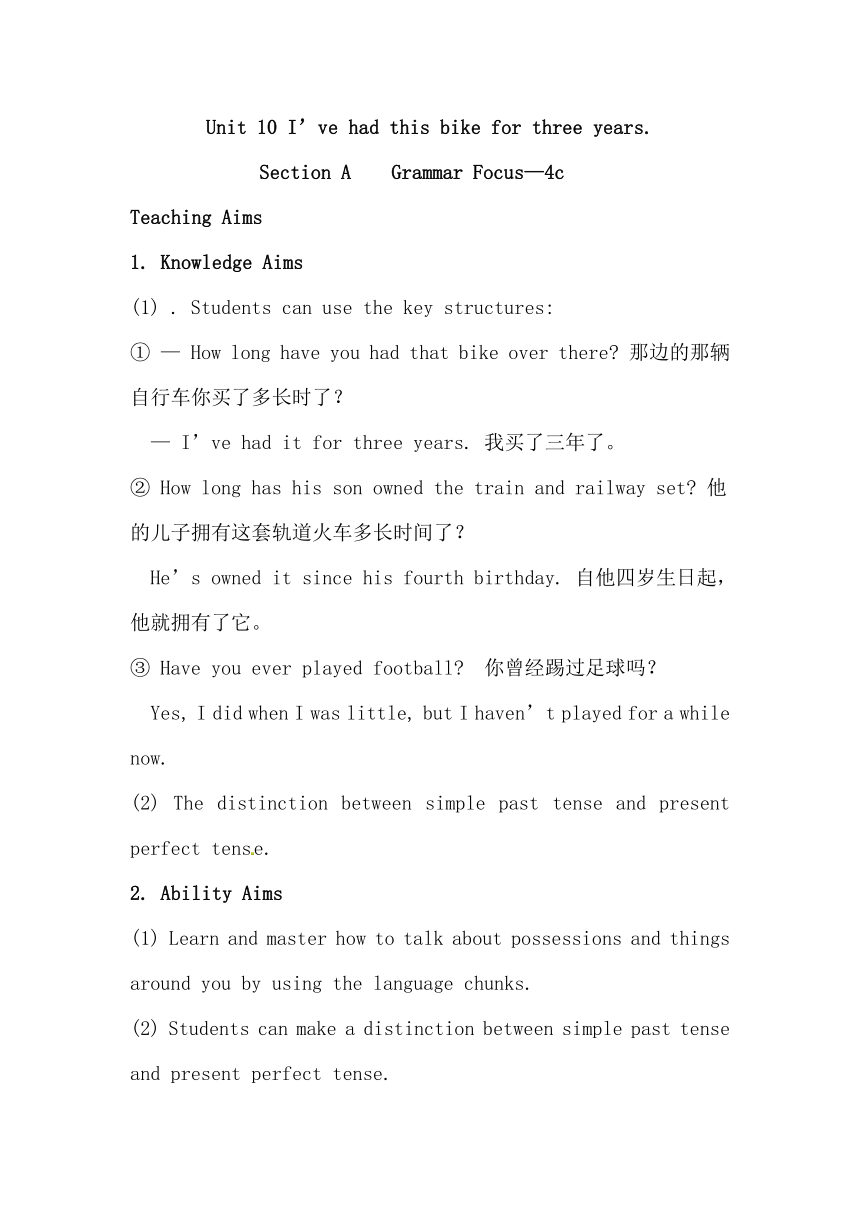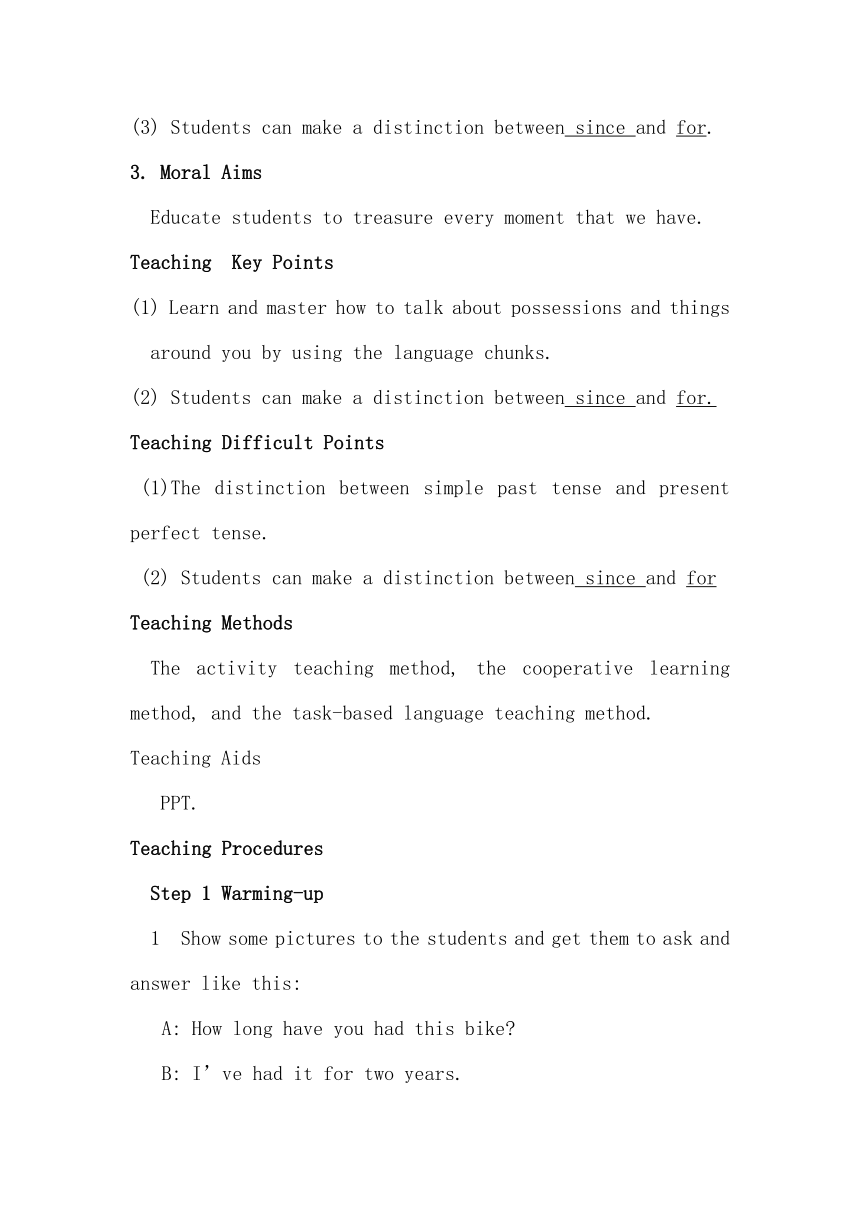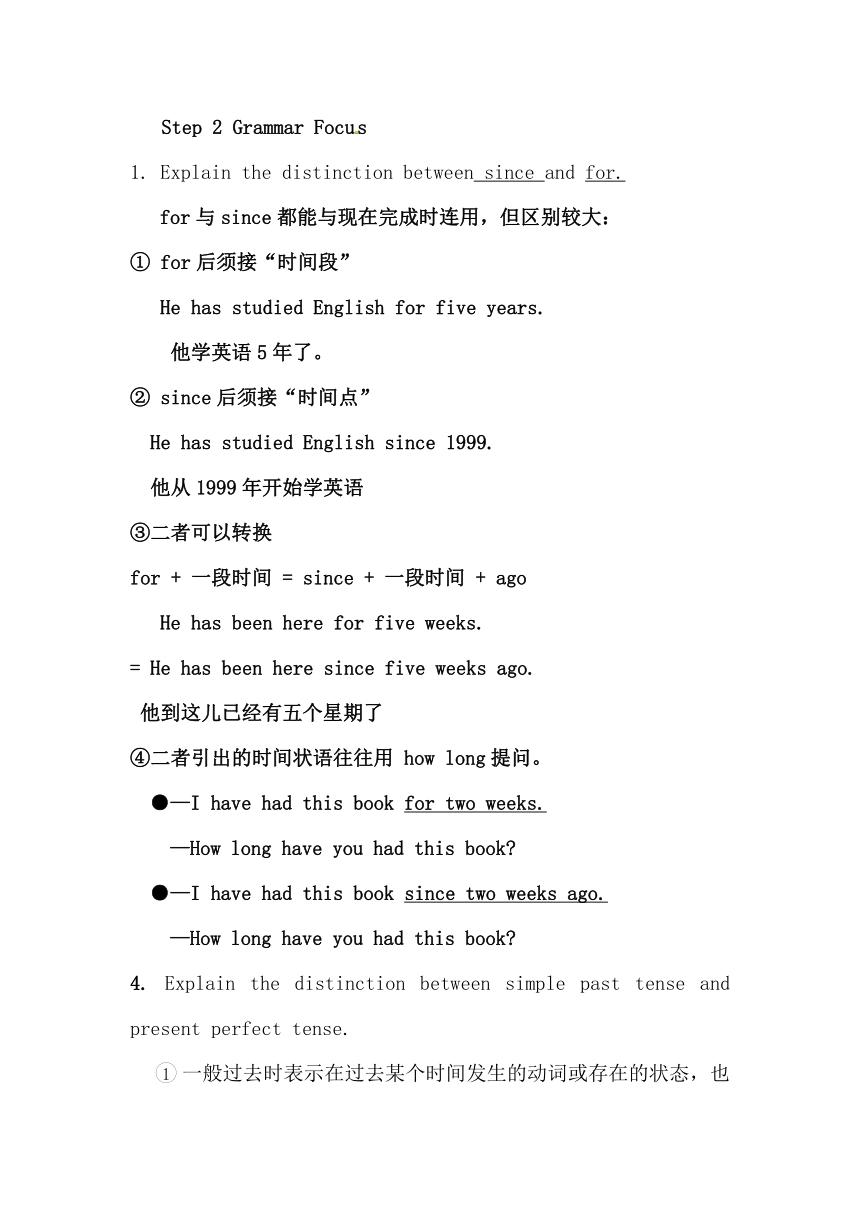人教版八年级下册 Unit 10 I've had this bike for three years. Section A Grammar focus 4a-4c 教案
文档属性
| 名称 | 人教版八年级下册 Unit 10 I've had this bike for three years. Section A Grammar focus 4a-4c 教案 |  | |
| 格式 | doc | ||
| 文件大小 | 98.0KB | ||
| 资源类型 | 教案 | ||
| 版本资源 | 人教新目标(Go for it)版 | ||
| 科目 | 英语 | ||
| 更新时间 | 2022-12-24 17:18:44 | ||
图片预览



文档简介
Unit 10 I’ve had this bike for three years.
Section A Grammar Focus—4c
Teaching Aims
1. Knowledge Aims
(1) . Students can use the key structures:
① — How long have you had that bike over there 那边的那辆自行车你买了多长时了?
— I’ve had it for three years. 我买了三年了。
② How long has his son owned the train and railway set 他的儿子拥有这套轨道火车多长时间了?
He’s owned it since his fourth birthday. 自他四岁生日起,他就拥有了它。
③ Have you ever played football 你曾经踢过足球吗?
Yes, I did when I was little, but I haven’t played for a while now.
(2) The distinction between simple past tense and present perfect tense.
2. Ability Aims
(1) Learn and master how to talk about possessions and things around you by using the language chunks.
(2) Students can make a distinction between simple past tense and present perfect tense.
(3) Students can make a distinction between since and for.
3. Moral Aims
Educate students to treasure every moment that we have.
Teaching Key Points
(1) Learn and master how to talk about possessions and things around you by using the language chunks.
(2) Students can make a distinction between since and for.
Teaching Difficult Points
(1)The distinction between simple past tense and present perfect tense.
(2) Students can make a distinction between since and for
Teaching Methods
The activity teaching method, the cooperative learning method, and the task-based language teaching method.
Teaching Aids
PPT.
Teaching Procedures
Step 1 Warming-up
1 Show some pictures to the students and get them to ask and answer like this:
A: How long have you had this bike
B: I’ve had it for two years.
Step 2 Grammar Focus
1. Explain the distinction between since and for.
for与since都能与现在完成时连用,但区别较大:
① for后须接“时间段”
He has studied English for five years.
他学英语5年了。
② since后须接“时间点”
He has studied English since 1999.
他从1999年开始学英语
③二者可以转换
for + 一段时间 = since + 一段时间 + ago
He has been here for five weeks.
= He has been here since five weeks ago.
他到这儿已经有五个星期了
④二者引出的时间状语往往用 how long提问。
●—I have had this book for two weeks.
—How long have you had this book
●—I have had this book since two weeks ago.
—How long have you had this book
4. Explain the distinction between simple past tense and present perfect tense.
1 一般过去时表示在过去某个时间发生的动词或存在的状态,也表示过去经常或反复发生的动作。e.g. He came here yesterday.
2 现在完成时表示过去的动作(或状态)对现在产生的影响和结果
3 e.g. He has broken his bottle.
③构成不同Tom went to London last year.
Lily has been to London twice.
一般过去时的谓语动词用过去式,
现在完成时的谓语用“助动词have /has +过去分词”
④ 用法不同: 现在完成时是表示过去的动作与现在的联系,主要说明的是现在的情况和状态;而一般过去时则强调动作发生在过去某一时间,与现在不发生联系.
I had supper an hour ago.我一小时前吃的晚饭。(表示过去的动作)
I have just had supper.我刚刚吃过晚饭。(强调对现在的影响———我不饿)
He was a teacher then.他那时是个教师。(表示过去的状态)
He has been a teacher since then.他从那时起一直当教师。(他现在还是教师)
⑤一般过去时常与表示过去的具体时间状语连用,现在完成时常与表示一段时间的时间状语连用,或无时间状语。
一般过去时的时间状语: yesterday, once, last week, ... ago, in 1980, in October, just now等具体的时间状语。
现在完成时的时间状语:
for, since, so far, ever, never, just, yet, till, up to now, always等不确定的时间状语。
⑥ The students do some exercise:
Choose the right answer or fill in the blanks with the proper form of the words given.
(1). --I have seen the film "127 hours" already.
--When ____ you ____ it
A. have, seen B. will see
C. did, see D. did, seen
(2). Mr. Black ____ in China since five years ago.
A. lived B. has lived
C. lives D. is going to live
(3). - -- ______ Uncle Wang ______ (mend) the TV yet
---Yes, he______.
---When _____ he _____ it
--- Yesterday.
(4). ---I ________ (see) the film "Chicken Run".
--- Where and when ________ you _______ (see) it --- Last week.
(5). ---____ you _____ (see) the film last night
---No, I _____ (see) it for several times.
(6). ---_______ you _______ (return) the book to the library
--- Not yet. But I _________ (return) it this afternoon..
Step 3 Practice (4a)
Ask the students to rewrite the sentences using for or since after the model 1.
1. Check the answers.
Step 4 Practice (4b)
1. Ask the students to fill the blanks with the correct forms of the verbs in brackets.
2. Check the answers.
Step 5 Group work (4c)
1. Get the students to work in pairs and fill the blanks.
2. Get the students to complete the chart.
3. Get the students to write a report like this according to the chart:
Tony has a favorite book. He has it for two years. He owns a bike. He has owned it since he was ten years old.……
PAGE
Section A Grammar Focus—4c
Teaching Aims
1. Knowledge Aims
(1) . Students can use the key structures:
① — How long have you had that bike over there 那边的那辆自行车你买了多长时了?
— I’ve had it for three years. 我买了三年了。
② How long has his son owned the train and railway set 他的儿子拥有这套轨道火车多长时间了?
He’s owned it since his fourth birthday. 自他四岁生日起,他就拥有了它。
③ Have you ever played football 你曾经踢过足球吗?
Yes, I did when I was little, but I haven’t played for a while now.
(2) The distinction between simple past tense and present perfect tense.
2. Ability Aims
(1) Learn and master how to talk about possessions and things around you by using the language chunks.
(2) Students can make a distinction between simple past tense and present perfect tense.
(3) Students can make a distinction between since and for.
3. Moral Aims
Educate students to treasure every moment that we have.
Teaching Key Points
(1) Learn and master how to talk about possessions and things around you by using the language chunks.
(2) Students can make a distinction between since and for.
Teaching Difficult Points
(1)The distinction between simple past tense and present perfect tense.
(2) Students can make a distinction between since and for
Teaching Methods
The activity teaching method, the cooperative learning method, and the task-based language teaching method.
Teaching Aids
PPT.
Teaching Procedures
Step 1 Warming-up
1 Show some pictures to the students and get them to ask and answer like this:
A: How long have you had this bike
B: I’ve had it for two years.
Step 2 Grammar Focus
1. Explain the distinction between since and for.
for与since都能与现在完成时连用,但区别较大:
① for后须接“时间段”
He has studied English for five years.
他学英语5年了。
② since后须接“时间点”
He has studied English since 1999.
他从1999年开始学英语
③二者可以转换
for + 一段时间 = since + 一段时间 + ago
He has been here for five weeks.
= He has been here since five weeks ago.
他到这儿已经有五个星期了
④二者引出的时间状语往往用 how long提问。
●—I have had this book for two weeks.
—How long have you had this book
●—I have had this book since two weeks ago.
—How long have you had this book
4. Explain the distinction between simple past tense and present perfect tense.
1 一般过去时表示在过去某个时间发生的动词或存在的状态,也表示过去经常或反复发生的动作。e.g. He came here yesterday.
2 现在完成时表示过去的动作(或状态)对现在产生的影响和结果
3 e.g. He has broken his bottle.
③构成不同Tom went to London last year.
Lily has been to London twice.
一般过去时的谓语动词用过去式,
现在完成时的谓语用“助动词have /has +过去分词”
④ 用法不同: 现在完成时是表示过去的动作与现在的联系,主要说明的是现在的情况和状态;而一般过去时则强调动作发生在过去某一时间,与现在不发生联系.
I had supper an hour ago.我一小时前吃的晚饭。(表示过去的动作)
I have just had supper.我刚刚吃过晚饭。(强调对现在的影响———我不饿)
He was a teacher then.他那时是个教师。(表示过去的状态)
He has been a teacher since then.他从那时起一直当教师。(他现在还是教师)
⑤一般过去时常与表示过去的具体时间状语连用,现在完成时常与表示一段时间的时间状语连用,或无时间状语。
一般过去时的时间状语: yesterday, once, last week, ... ago, in 1980, in October, just now等具体的时间状语。
现在完成时的时间状语:
for, since, so far, ever, never, just, yet, till, up to now, always等不确定的时间状语。
⑥ The students do some exercise:
Choose the right answer or fill in the blanks with the proper form of the words given.
(1). --I have seen the film "127 hours" already.
--When ____ you ____ it
A. have, seen B. will see
C. did, see D. did, seen
(2). Mr. Black ____ in China since five years ago.
A. lived B. has lived
C. lives D. is going to live
(3). - -- ______ Uncle Wang ______ (mend) the TV yet
---Yes, he______.
---When _____ he _____ it
--- Yesterday.
(4). ---I ________ (see) the film "Chicken Run".
--- Where and when ________ you _______ (see) it --- Last week.
(5). ---____ you _____ (see) the film last night
---No, I _____ (see) it for several times.
(6). ---_______ you _______ (return) the book to the library
--- Not yet. But I _________ (return) it this afternoon..
Step 3 Practice (4a)
Ask the students to rewrite the sentences using for or since after the model 1.
1. Check the answers.
Step 4 Practice (4b)
1. Ask the students to fill the blanks with the correct forms of the verbs in brackets.
2. Check the answers.
Step 5 Group work (4c)
1. Get the students to work in pairs and fill the blanks.
2. Get the students to complete the chart.
3. Get the students to write a report like this according to the chart:
Tony has a favorite book. He has it for two years. He owns a bike. He has owned it since he was ten years old.……
PAGE
同课章节目录
- Unit 1 What's the matter?
- Section A
- Section B
- Unit 2 I'll help to clean up the city parks.
- Section A
- Section B
- Unit 3 Could you please clean your room?
- Section A
- Section B
- Unit 4 Why don't you talk to your parents?
- Section A
- Section B
- Unit 5 What were you doing when the rainstorm came
- Section A
- Section B
- Review of Units 1-5
- Unit 6 An old man tried to move the mountains.
- Section A
- Section B
- Unit 7 What's the highest mountain in the world?
- Section A
- Section B
- Unit 8 Have you read Treasure Island yet?
- Section A
- Section B
- Unit 9 Have you ever been to a museum?
- Section A
- Section B
- Unit 10 I've had this bike for three years.
- Section A
- Section B
